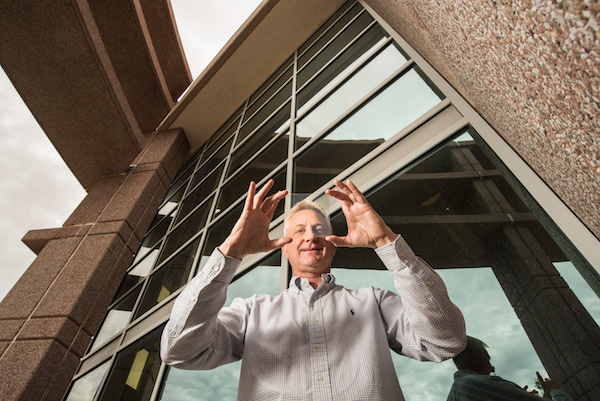
[Image above] Sandia National Laboratories materials physicist Paul Clem holds a sample of nanoparticle-coated glass. Credit: Randy Montoya; Sandia National Laboratories
Windows have been an important area of research—and funding—for quite some time. One of the U.S. Department of Energy’s strategic goals is to “improve the energy efficiency of our homes, buildings, and industries,” according to its website. Reducing our carbon footprint is an important goal of many efforts in scientific research and the federal government.
In the last decade, we’ve seen advancements in window technologies such as self-powered and self-tinting windows. We’ve reported on user-controlled electrochromic windows and windows that change colors.
Now, through a partnership between Sandia National Laboratories and private manufacturer IR Dynamics, scientists are creating window films for buildings and cars that incorporate thermochromic technology to use nanoparticles to reflect heat and infrared radiation.
Paul Clem, materials physicist at Sandia, and William Kurtz of IR Dynamics—with the help of a New Mexico Small Business Assistance grant— joined forces to develop a window material that would save energy and automatically change its tint based on temperature. They used vanadium dioxide due to its thermochromic properties—the ability to change color or opacity during temperature changes, something electrochromic materials cannot do without additional help.
Electrochromic materials are powered by an electrical charge and require users to flip a switch to control the amount of tint or opacity. They also require a circuit to run an electric current, making electrochromics a more expensive technology to incorporate into windows.
Clem and the Sandia team created nanoparticles made of VO2 and mixtures of other metals. Chemist and team member Nelson Bell blended the metals into a mixture that could be discharged like spray paint onto a surface, such as a window. By adding different quantities of metals, the scientists were able to produce different batches capable of reflecting heat at temperatures ranging from 200o F to –40o F.
This was important because different applications might require different temperature ranges to reflect or absorb heat. For example, warmer climates might need windows that begin reflecting heat at lower temperatures.
The final step in the research involved characterizing nanoparticle batches to determine their physical properties, absorbing temperatures, and chemical structure.
Scaling up for energy-saving windows
Clem and his team are working with IR Dynamics to produce a film for homeowners to add to their existing windows to lower utility bills. According to Sandia’s news release, “Future applications include incorporating the nanoparticles into new windows, adding them to architectural plastics, such as the kind used in the Water Cube of the 2008 Beijing Olympics, or high-performance athletic clothing.”
“The process to scale-up is progressing smoothly so far and is currently scaled up to provide technical samples for evaluation by end users,” Clem writes in an email. “Scale-up to pilot production is beginning in a new IR Dynamics facility.”
It’s important to note that most small businesses don’t have the resources and budget to conduct this type of research. That’s why partnerships like this are critical in getting energy-saving products to market. Last year, the DOE awarded IR Dynamics a $1.95 million grant from its SHIELD program to help get the company’s window films to market. The company already has filed several patents on this latest process.
“It is important for small technology companies like ours to be able to partner with the national laboratories,” Kurtz says in the release. “I think that it is part of what keeps us competitive as a nation with the rest of the world.”
“It’s rewarding to see things go from idea to a commercial product,” Clem adds. “Seeing new companies start up and grow knowing you’ve given them a technical boost is satisfying. Sandia continues to support technology transfer and technical measurements of the scaled-up materials being produced by IR Dynamics for multiple applications.”
